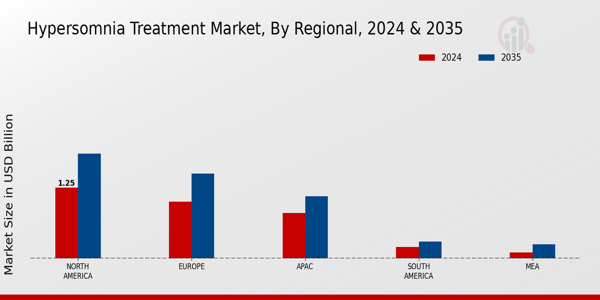Market Growth Projections
The Global Hypersomnia Treatment Market Industry is projected to grow significantly, with estimates indicating a market value of 3.36 USD Billion in 2024 and a potential increase to 5 USD Billion by 2035. This growth trajectory suggests a compound annual growth rate (CAGR) of 3.68% from 2025 to 2035, reflecting the increasing demand for effective hypersomnia treatments. The market's expansion is driven by various factors, including advancements in treatment modalities, rising healthcare expenditure, and growing awareness of sleep disorders. These projections underscore the importance of continued investment in research and development to meet the needs of affected individuals.
Rising Healthcare Expenditure
The upward trend in global healthcare expenditure is a significant factor propelling the Global Hypersomnia Treatment Market Industry. As countries allocate more resources to healthcare, there is a corresponding increase in funding for research and development of new treatments for sleep disorders. This financial commitment facilitates the introduction of advanced therapies and technologies, enhancing treatment accessibility for patients. With a compound annual growth rate (CAGR) of 3.68% anticipated from 2025 to 2035, the market is poised for sustained growth, reflecting the increasing prioritization of sleep health within healthcare systems worldwide.
Growing Awareness and Education
Increased awareness and educational initiatives surrounding hypersomnia play a crucial role in driving the Global Hypersomnia Treatment Market Industry. Organizations and healthcare professionals are actively promoting understanding of sleep disorders, leading to earlier diagnosis and treatment. Campaigns aimed at educating the public about the symptoms and consequences of hypersomnia are gaining traction, resulting in more individuals seeking medical help. This heightened awareness is expected to contribute to market growth, as evidenced by the projected increase in market value to 5 USD Billion by 2035, indicating a sustained commitment to addressing this condition.
Regulatory Support and Approvals
Regulatory support and streamlined approval processes for new treatments are vital drivers of the Global Hypersomnia Treatment Market Industry. Regulatory agencies are increasingly recognizing the need for effective therapies for hypersomnia, leading to expedited review processes for promising medications. This supportive environment encourages pharmaceutical companies to invest in research and development, resulting in a broader array of treatment options for patients. As new therapies receive approval, the market is likely to experience accelerated growth, contributing to the overall expansion of the industry.
Advancements in Treatment Modalities
Innovations in treatment modalities significantly influence the Global Hypersomnia Treatment Market Industry. The development of new pharmacological agents, such as wakefulness-promoting medications, has transformed the therapeutic landscape. For instance, medications like modafinil and pitolisant have shown promising results in clinical trials, enhancing patient outcomes. Furthermore, ongoing research into combination therapies and non-pharmacological interventions, such as cognitive behavioral therapy, is likely to expand treatment options. These advancements not only improve patient quality of life but also stimulate market growth, as healthcare providers seek effective solutions for managing hypersomnia.
Increasing Prevalence of Hypersomnia
The rising incidence of hypersomnia is a primary driver of the Global Hypersomnia Treatment Market Industry. As awareness of sleep disorders increases, more individuals are being diagnosed with conditions such as idiopathic hypersomnia and narcolepsy. According to recent data, the prevalence of hypersomnia is estimated to affect approximately 5 to 10 percent of the population. This growing recognition leads to an increased demand for effective treatment options, contributing to the market's expansion. By 2024, the market is projected to reach 3.36 USD Billion, reflecting the urgent need for innovative therapies and management strategies.






















Leave a Comment